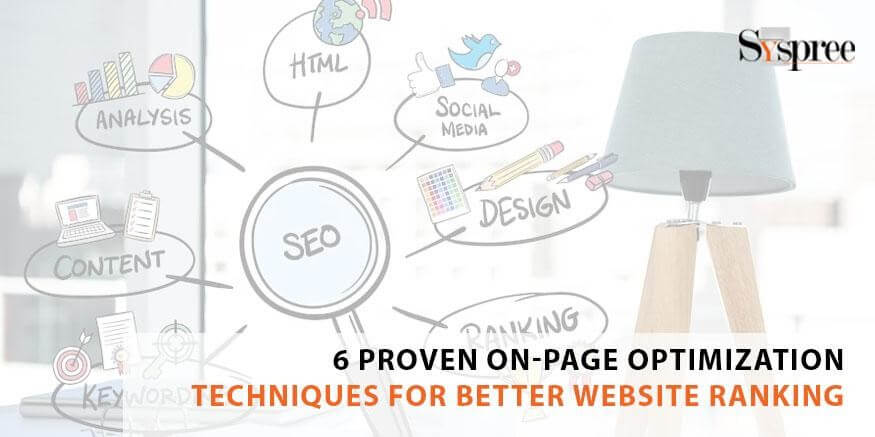Are you trying to increase your site’s ranking on search engines? Are you looking to master the most efficient strategies for On-page optimization of your site’s pages that will assist you in achieving a higher web page rank? You’re in the right spot!
A top digital marketing agency states that appropriate On-page optimization methods will allow you to improve the quality of your content, such as images, keywords and URLs, as well as internal linking, as well as mobile-friendly to ensure that search engines can browse and index your website quickly. So, if you want to know how to improve your website’s search engine rankings, continue reading and let’s begin!
Key Takeaways
- On-page optimization of your website is vital to improving the position of your website on search results webpages (SERPs).
- Search engine optimization and keyword research are essential for the On-page optimization of your website’s performance. It is crucial to determine your target audience’s objectives, identify relevant keywords, analyze the metrics associated with keywords, analyze competitor analysis and then optimize the website’s content.
- Content optimization is the process of producing engaging, high-quality content, knowing the target audience and their goals, and optimizing the page’s title, meta descriptions, and headers.
- Image optimization is vital to ensure the speed of websites as well as user satisfaction. Images must be optimized, compressed, and compressed to size and format and include alt text.
- Internal linking, also known as links to pages on your site, can enhance the experience of users, website navigation and search engine search visibility.
Mastering On-Page Optimization: 6 Techniques to Boost Your Website Ranking

On-page optimization is an important aspect of search engine optimization
On-page optimization is an important aspect of search engine optimization (SEO) which can dramatically influence your website’s position on search engine result webpages (SERPs). By strategically optimizing different elements of your website, it can increase your site’s visibility, as well as user experience and ranking. Let’s look at the six key strategies discussed in this blog to help you master the art of on-page optimization to boost your site’s ranking.
Technique 1: Keyword Research and Optimization
Keywords are the basis of On-page optimization of your site’s performance and play a significant part in helping the search engine comprehend the importance and contents of your pages. When you conduct a thorough keyword study and optimize your site’s content to match, you can dramatically improve your site’s ranking within search result pages. The best SEO company shares a step-by-step guide for keyword analysis.
Step 1: Identify Your Target Audience and Goals
The first step of conducting search engine optimization is determining your audience’s goals and target. Find out who your intended group is, what they are searching for, and which terms are pertinent to your site’s content.
Step 2: Brainstorm Relevant Keywords

Brainstorm Relevant Keywords
Then, create your list of keywords that relate to your site’s content and will likely get the attention of your intended users in their search queries. Consider what potential customers may be searching to find when looking for goods or services similar to those you provide.
Step 3: Analyze Keyword Metrics
Once you’ve compiled an idea of the keywords you could use, look at the metrics of each to assess their efficacy. Search for keywords with significant search volume and little competition, as they are more likely to drive visitors to your site.
Step 4: Conduct a Competitor Analysis
Examine your competitors’ keywords to gain insight into the SEO strategy. Find out the keywords they are trying to rank for and target and determine whether your site has any holes or potential.
Step 5: Optimize Your Content
After you’ve compiled a keyword list, you need to optimize your website’s content. Integrate the keywords strategically in your meta descriptions and header tags, URL optimization, and content optimization.
Technique 2: Content Optimization
Content is the most important thing when it comes to On-page optimization, and creating quality, engaging, and SEO-friendly content is crucial to improve the search engine ranking of your site. Allow a leading content marketing company in India to assist you in content optimization.
Tip 1: Understand Your Audience and Intent
Before creating content, you must be aware of your target audience and their goals. What do they want? What are their concerns? What problems are they attempting to solve? Knowing your audience’s requirements and motivations will allow you to develop useful and valuable material for them.
Tip 2: Create High-Quality and Engaging Content
Producing engaging and high-quality content is the key to capturing and retaining the interest of your viewers. Your content must be well-written, clear, informative and straightforward to comprehend. Avoid using duplicate content, which could affect your website’s position in search results.
Tip 3: Optimize Page Titles, Meta Descriptions, and Headers
- Page Titles: Put your keyword of choice in the title of your page and, ideally, in the beginning, indicate its importance to users and search engines. Make sure the title is concise, clear, informative and engaging.
- Meta Descriptions: Utilize your keywords in your meta description to provide an appealing and concise description of your website’s contents. This can increase the click-through rate (CTR) on search results and encourage people to click on your hyperlink.
- Headers: Integrate your keywords into header tags (such as H1, H2 or H3.) to organize your site’s content and emphasize key headings. This will help search engines recognize the layout of your page and boost its authority.
Tip 4: Optimize for Readability and User Experience
Optimizing your content to be readable and providing a positive user experience is vital to getting them to stay on your site. Use short and concise sentences, break up lengthy paragraphs, and use bullet points or lists of numbers to make your information simple to read and comprehend.
Tip 5: Use Internal and External Links
Integrating external and internal links into your content could help improve your website’s SEO performance. Internal links are those that connect one page on your site to another, and external hyperlinks are those that link from your site to other websites.
Technique 3: URL Optimization

URL Optimization
URLs are among the most crucial factors search engines utilize to determine the relevancy of a website page in response to a search query. It is, therefore, crucial for you to improve your URLs in order to ensure they are SEO-friendly. A top SEO company in Singapore recommends best practices for creating SEO-friendly URLs.
Best Practices for Creating SEO-friendly URLs
Here are some of the best methods to create SEO-friendly URLs
- Utilize hyphens to separate words within the URL instead of spaces, underscores, or underlines.
- Keep the URL brief and straight to the point, and include relevant keywords.
- Use lowercase letters for the URL since uppercase letters can create confusion.
- Beware of using stop words such as “and,” “the,” and “of” in the URL since they do not add any value to the query.
- Use static URLs instead of dynamic URLs containing session IDs or parameters.
Technique 4: Image Optimization
Images can enhance users’ experience when visiting your site and help increase your search rankings. It is crucial to improve your images’ SEO to ensure that they are easily indexed and crawled by search engines. Allow a digital marketing agency to guide you in Image optimization.
Best Practices for Optimizing Images for SEO
Here are some top methods to optimize pictures for Search Engine Optimization:
- Utilize high-quality images appropriate to the content on the page.
- Reduce the size of the image to speed up loading time.
- Make sure to use descriptive and appropriate names for the file.
- Utilize alt texts to describe the image to users who are visually impaired as well as to help search engines.
- Include a descriptive caption to the photo, if appropriate.
Tips for Using Alt Text and Image File Names
Alt texts are used to describe an image’s contents to people with visual impairments and search engines. The best SEO company shares some suggestions for using alt text as well as images file names:
- Utilize descriptive alt texts that precisely describe the contents of the photo.
- Use relevant keyword phrases in the alt-text; do just what is necessary with keywords.
- Use hyphens for terms in text in an alt and the name of the image file.
- Make sure to keep the alt text and name of the image file brief and straight to the point.
Technique 5: Internal Linking
Internal linking is an essential aspect of on-page optimization and could significantly affect your site’s rank. Internal linking is linking one web page of your site to another page on the same site. Internal links assist search engines in understanding the layout of your site and the relation between various pages.
Tips for Creating a Strong Internal Linking Structure
Here are some suggestions to create a solid inner linking structure
- Utilize anchor words that accurately describe the page contents you are linking to.
- Links to websites that are useful and relevant for the user.
- Use the appropriate and descriptive title for your link, which accurately defines the contents of the page linked to.
- Create a consistent and structured design for internal hyperlinks, making it easier for visitors to navigate your site.
Best Practices for Using Anchor Text in Internal Links
Here are the best practices for anchor text to be used in internal hyperlinks:
- Use appropriate and descriptive anchor words that accurately describe the contents of the page linked to.
- The phrases “click here” and “read more” should not be used as anchor text.
- Utilize variations of the targeted word in anchor texts but be careful not to overdo it.
- Use long-tail keywords within the anchor text to reach particular groups of people.
Technique 6: Mobile Optimization

Mobile Optimization
With the increasing popularity number of devices on mobiles, it’s crucial to ensure your website is mobile-friendly. Mobile optimization makes your website available and easy to access on mobile devices such as tablets and smartphones.
A top content marketing company in India states that responsive web design is one of the crucial aspects of On-page optimization since most people use mobile devices to access websites.
Best Practices for Creating a Mobile-Friendly Website
Here are some of the best techniques for building mobile-friendly websites:
- Utilize responsive design to ensure that your site adapts to various screen sizes.
- Make use of a mobile-friendly content management system (CMS) that is designed for mobile devices.
- Reduce the navigation menu and make it simple for users to locate the information they’re seeking.
- Make use of large, easy-to-read fonts designed to work with mobile devices.
- Make sure your videos and images are optimized on mobiles.
Tips for Optimizing Website Speed and User Experience on Mobile Devices
Here are some helpful tips to optimize the speed of websites and the user experience on mobile devices:
- Use a content delivery network (CDN) to accelerate your website’s loading speed.
- Optimize your website’s code to reduce the amount of HTTP requests.
- Reduce the number of large videos and images that could slow down your website.
- Utilize caching to store frequently used information and reduce the time it takes to load pages.
- Test your website on a variety of devices on mobile to make sure it functions properly on every platform.
The Importance of Backlinking in SEO
Backlinking is an essential aspect of On-page optimization that can assist your website in building authority and improving its position in SERPs. A backlink is a link that is created from one website to another. It proves trust in the high quality of the website’s content.
The more backlinks you can get from websites with high authority, the more likely you will be ranked higher in the search results. It is important to ensure your backlinks come from reliable sources and are pertinent to your site’s content. Allow a top SEO company in Singapore to create good-quality backlinks.
Ineffective backlinks coming from sites that are not relevant or spammy are more harmful than good, resulting in penalizations or even having your website blacklisted from search engine results. So, it’s essential to build quality backlinks that are reliable and credible sources to improve your site’s rank and boost the visibility of your website online.
Conclusion:
Ultimately, on-page optimization is a key factor in boosting your website’s rank and attracting the right visitors. Implementing the six tested methods discussed in this article to build a more SEO-friendly website provides a better user experience. Ensure you constantly monitor your website’s performance and make any necessary adjustments to stay ahead of your competitors. By putting in the time and effort, you can improve your web page rankings and achieve success. Did you find this blog post interesting? Be sure to check out our previous blog post on Dominate Search Rankings Effectively with These 5 Algorithmic Hacks.







